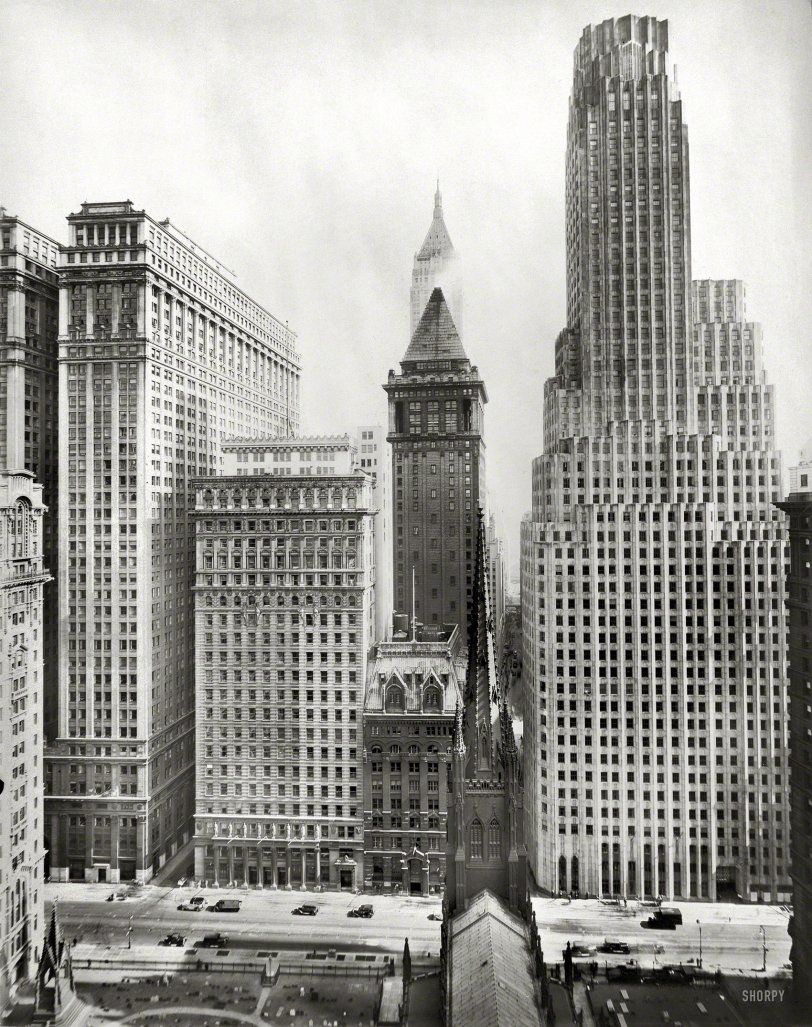


Framed or unframed, desk size to sofa size, printed by us in Arizona and Alabama since 2007. Explore now.
Shorpy is funded by you. Patreon contributors get an ad-free experience.
Learn more.

- Freeze Frame
- Texas Flyer wanted
- Just a Year Too Soon
- WWII -- Replacing men with women at the railroad crossing.
- Yes, Icing
- You kids drive me nuts!
- NOT An Easy Job
- I wonder
- Just add window boxes
- Icing Platform?
- Indiana Harbor Belt abides
- Freezing haze
- Corrections (for those who care)
- C&NW at Nelson
- Fallen Flags
- A dangerous job made worse
- Water Stop
- Passenger trains have right of way over freights?
- Coal
- Never ceases to amaze me.
- Still chuggin' (in model form)
- Great shot
- Westerly Breeze
- For the men, a trapeze
- Tickled
- Sense of loneliness ...
- 2 cents
- Charm City
- What an Outrage
- Brighton Park
Print Emporium
Irving Trust: 1931

New York circa 1931. "Irving Trust Building, 1 Wall Street." The Art Deco behemoth on the right, with Trinity Church and its cemetery in the foreground and Equitable Building on the left, along with American Surety, the Bankers Trust pyramid and Bank of Manhattan (rear). Irving Underhill photo. View full size.
100 Broadway
Note the two-tone American Surety building just left of center at 100 Broadway-- the darker left part is 20+ years older than the lighter addition.
In Defense of the Equitable Building
The connection between the construction of the [Second] Equitable Building (built 1913-1915) and the passage of the New York Zoning Ordinance of 1916 is more elusive than is commonly thought. Skyscraper regulation had been under consideration in New York for many years before the Equitable was built, and the basics of the Zoning Ordinance were finalized in 1913 - when the Equitable was merely a hole in the ground; it took several years for the City Council to take action. It was the model suggested by architect Ernest Flagg in his Singer Tower of 1906-1908 that led the way for the height and bulk restrictions of the ordinance, with the crucial proviso that a tower of unlimited height could be built on 25% of the lot area. So the Equitable Building is not really the big, bad, monster building it is often made out to be.
Dark shadows
Construction of the Equitable Building led to New York's first commercial zoning regulations almost a century ago. By running straight up 38 stories from the property line without setbacks, the building cast surrounding buildings in perpetual shadow. Not only was this esthetically unpleasing, it also was quite burden at a time when offices still relied on natural light to a significant extent. Some building owners were able to get their property taxes reduced by proving loss of market value. In response, the city enacted zoning rules that required setbacks in tall buildings, rules that remained in effect for decades and can still be seen in the profiles of buildings constructed in the 1920's and 1930's, for example the Irving Trust (now Bank of New York Mellon) Building on the right side of this photo.
An unusual thing about this photo is that every building is still standing, with the exception of the one directly to the left of the steeple.
Addendum: Ironically, Flagg's narrow-tower design of the Singer Building is a major reason why it became the tallest building ever intentionally demolished, a record it still holds after more than 45 years. Its floorplates were so small that the building was obsolete for modern office uses.
Once the tallest
Trinity's spire was once the tallest structure in New York City.
It was a tourist desitination to climb inside the spire.
I once got to do that about 11 years ago. It was sooty, awkward footing, and there was more than one dead pidgeon up there.
But I did it.
[Walter? -tterrace]
Man on a Ledge X 2
Here we go again with a Man on a Ledge, this time twice in 1 photo. 1 is left of the church 16 floors up, the other right of the church 12 floors up. Amazing!
Much the same
With the exception of that short building on the north side of Wall Street, they are all there including the Banker's Trust pyramid and the Bank of Manhattan (not in this frame).

























On Shorpy:
Today’s Top 5